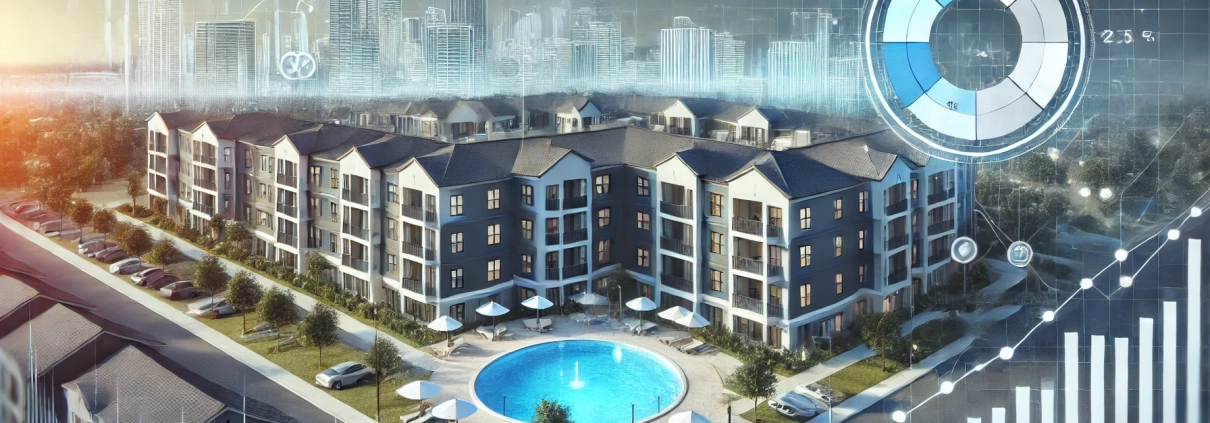Market Rent
The rent a typical tenant would pay for a comparable unit or suite in the same or comparable market. A real estate owner will often compare the average contract rental rate at their property, to the market rent in the area to determine whether there is potential to increase rents at the real estate owner’s property.
Putting ‘Market Rent’ in Context
Evergreen Property Partners, a real estate investment firm specializing in value-add acquisitions, recently acquired Greenfield Apartments, a 120-unit market-rate multifamily property in Charlotte, North Carolina. The property, built in 1990, features one- and two-bedroom units averaging 950 square feet, along with community amenities such as a swimming pool, fitness center, and clubhouse.
During the due diligence process, Evergreen conducted a detailed market rent analysis to compare Greenfield Apartments’ average in-place contract rents with the prevailing market rent in the area. This analysis revealed the following:
- In-place contract rent: $1,250 per unit per month (on average)
- Market rent for comparable properties: $1,400 per unit per month (on average)
The $150 per unit per month gap between in-place rents and market rents suggested significant upside potential through rent increases. However, further analysis revealed that many of the units at Greenfield Apartments had original fixtures and finishes, making them less competitive compared to recently renovated properties in the submarket.
To capitalize on the gap between in-place rents and market rents, Evergreen implemented a unit renovation plan. Each renovated unit would receive updated flooring, stainless steel appliances, modern lighting, and fresh paint, at an average cost of $8,000 per unit. Evergreen estimated that the renovations would allow them to achieve rents closer to market levels.
Financial Projections:
- Renovation Cost Per Unit: $8,000
- Expected Rent Increase Post-Renovation: $150 per month
- Payback Period Calculation:
Payback Period = Renovation Cost / Annual Rent Increase
= $8,000 / ($150 x 12)
= 4.44 years
The renovations were planned to be phased over two years to minimize disruption and maintain occupancy. By achieving market rents after renovations, Evergreen projected an increase in annual Net Operating Income (NOI) of $216,000, calculated as:
NOI Increase = Rent Increase x Number of Units x 12 months
= $150 x 120 x 12
= $216,000
This case illustrates how understanding market rent provides valuable insight into a property’s income potential and helps identify value-add opportunities for increasing profitability.
Frequently Asked Questions about Market Rent in Real Estate
What is market rent?
Market rent is “the rent a typical tenant would pay for a comparable unit or suite in the same or comparable market.” It serves as a benchmark for assessing a property’s rental performance and potential.
Why is market rent analysis important during due diligence?
It helps investors identify discrepancies between current contract rents and prevailing market rates, revealing opportunities for income growth. For example, Evergreen Property Partners found a $150/month gap between in-place and market rents at Greenfield Apartments.
How can property owners close the gap between in-place and market rent?
By renovating units to improve their competitiveness—such as updating flooring, appliances, and finishes—owners can justify higher rents that match market levels.
What was Evergreen’s renovation strategy at Greenfield Apartments?
Evergreen invested $8,000 per unit to install updated flooring, stainless steel appliances, modern lighting, and fresh paint, aiming to close the $150/month rent gap.
What is the payback period for Evergreen’s renovation investment?
The payback period is 4.44 years, calculated by dividing the $8,000 renovation cost by the $1,800 annual rent increase ($150 × 12).
How much additional NOI did Evergreen project from achieving market rent?
They projected a $216,000 annual increase in Net Operating Income (NOI), based on $150 rent increases across 120 units at full occupancy.
How does market rent influence value-add investment strategy?
It identifies underperforming properties with rent growth potential. By aligning rents with market levels through renovations, investors can increase NOI and enhance asset value.
Click here to get this CRE Glossary in an eBook (PDF) format.

